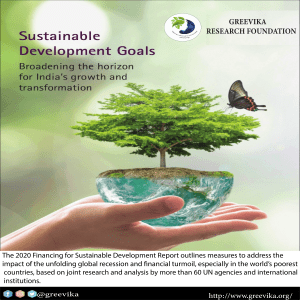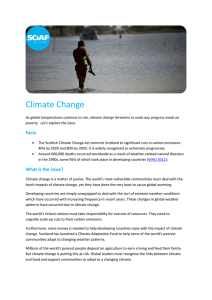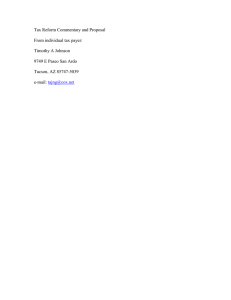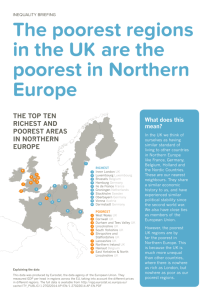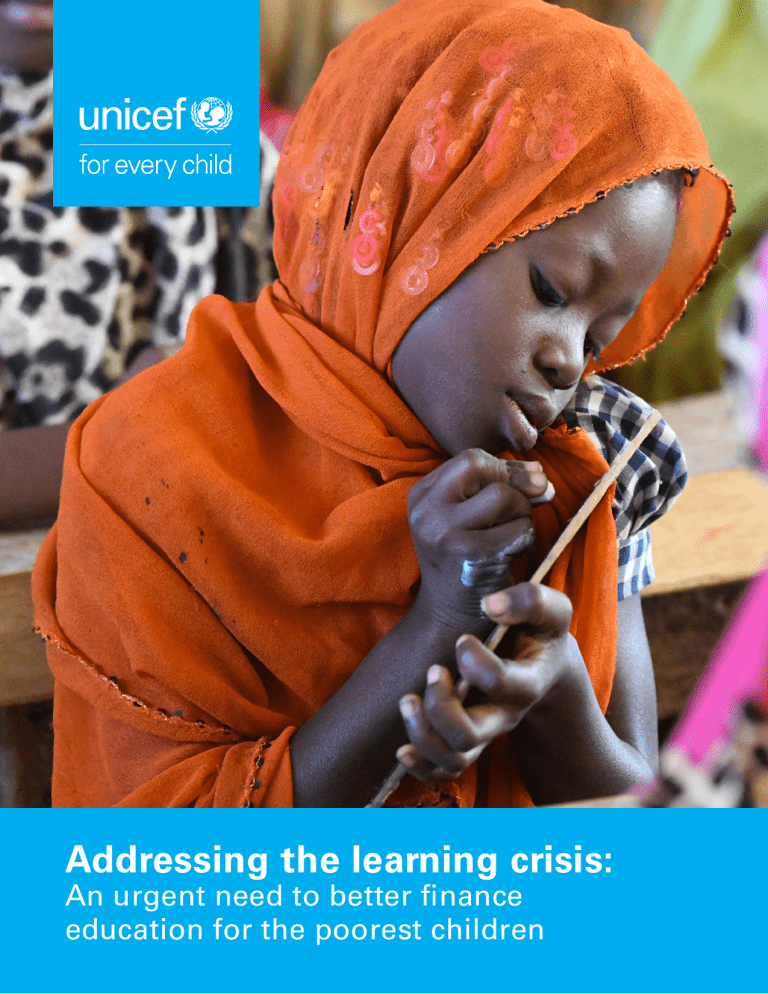
1 Addressing the learning crisis: An urgent need to better finance education for the poorest children Addressing the learning crisis: An urgent need to better finance education for the poorest children 2 Addressing the learning crisis: An urgent need to better finance education for the poorest children Introduction Although more children than ever before are enrolled in school, for too many, schooling does not equal learning. In 2016, over 600 million children and adolescents were estimated to be not reaching minimum proficiency levels in reading and mathematics.i To highlight the global learning crisis, the World Bank has introduced the concept of ‘Learning Poverty’ – the inability to read and understand a simple text by age 10. The concept draws on new data developed in coordination with the UNESCO Institute for Statistics (UIS). An estimated 53 per cent of children in low- and middle-income countries cannot read proficiently by age 10.ii Even so, solid progress on getting children into school has been made. The near universalization of primary schooling is one of the great global achievements of the past 50 years. In the early 1950s, some 50 per cent of primary school-aged children were out of school. Today, that figure has come down to 9 per cent.iii But, going through school without learning critical foundational skills – literacy, numeracy, digital and transferable skills like problem-solving and critical-thinking – is a tragedy unfolding in a world being transformed by globalization and automation. For millions of children and young people, it will mean a future where they are unable to find productive employment, engage in active citizenship, or shape better futures for themselves, their families and their communities. The impact of education on reducing poverty is well established,1 with studies confirming education’s significant influence on a country’s economic development.iv The knowledge and skills provided by quality education accumulates human capital, increasing not only the productivity and employability of individuals, but also impacting the overall development of their countries. Equally critical are the returns of education on many areas of human development: from better health and women’s empowerment, to civic engagement and social cohesion. There are many dimensions to the learning crisis. But a key factor that affects quality of education is the availability of funding. Underinvestment in education can result in several conditions – from large class sizes and poor-quality teachers, to lack of supportive materials and poor school infrastructure – which negatively impact how and what children learn.v After the Millennium Development and Education For All Goals were adopted in 2000, there was an important focus on increasing the allocation of national resources to education. Between 2000-2015, many countries at different income levels saw an increase in public funding of education. In lowincome countries, education spending increased from on average 3.48 per cent of the GDP in 2000 to 3.82 per cent of the GDP in 2015. In lower middle-income countries, the average also went up: from 4.2 per cent to 4.64 per cent over the same period.2 However, many low-income countries attribute far lessvi than the 20 per cent of domestic resources to education, which is widely accepted as a benchmark target.3 Underinvestment in education can result in several conditions that negatively impact how and what children learn. 1 The evidence that education is a driver of national economic growth has been extensively studied and well accepted. Table 1 of the following publication has a summary of literature on economic returns to education: United Nations Children’s Fund, The Investment Case for Education and Equity, UNICEF, New York, January 2015, p 7, <www.unicef.org/publications/files/Investment_Case_for_Education_and_Equity_FINAL.pdf>, accessed December 2019 2 UNICEF calculations based on data from the UNESCO Institute for Statistics (UIS), Montreal < http://data.uis.unesco.org/>. 3 Two key targets for public financing of education identified in UNESCO’s Education 2030 Framework for Action are: i) allocating at least 4-6 per cent of gross domestic product to education; and/or ii) allocating at least 15-20 per cent of public expenditure to education. 3 Addressing the learning crisis: An urgent need to better finance education for the poorest children The equity challenge in education The challenges in the education sector will not be addressed solely by increased funding or higher spending. An equally important question is: how are education resources distributed across segments of society? Is public education funding, in theory, a service intended to be an equalizer, meeting the needs of the poorest and the most vulnerable children? Available evidence shows that there is a serious equity problem in the distribution of public financing. A UNICEF analysis on the allocation of public education resources in 2015 highlighted that the balance of public funding disproportionately benefitted the wealthiest students in many countries. On average, in low income countries, 46 per cent of the resources went to the top 10 per cent of students with the highest levels of education. In lower middle-income countries, the percentage was 26 per cent. These figures demonstrated that children from the wealthiest households were disproportionately favoured since they were the ones heavily represented among those with highest levels of education.vii The poorest children are often the hardest hit from multiple, compounding barriers in their access to quality education and learning. Many are poor or/and live in rural areas. Many may also face discrimination in relation to gender, disability, ethnic origin or the language of instruction. If we consider access to education, for example, a disaggregation of the data for children from the poorest households show staggering inequities (despite global school enrolment rates showing significant improvement over the years). Forty-four per cent of girls and 34 per cent of boys (10-19 years old) from the poorest families have never attended school or dropped out before completing primary education (see Graph 1). The exclusion of the poorest at each step of education – access, completion or learning – leads to low levels of learning and becomes a key driver of the global learning crisis. It is also critical to focus on the education funding for children during and in the aftermath of emergencies (see Box 1). GRAPH 1 Educational status of poorest quintile adolescents (age 10-19 years) Never attended Dropped out in primary In primary school In lower secondary school Dropped out in upper secondary In school: upper secondary Girls 30% Boys 20% 0% 30% 14% 14% 25% Dropped out in lower secondary 34% 50% 5% 6% 14% 18% 75% As much as 44 per cent of girls and 34 per cent of boys from the poorest quintile never attended any school or dropped out in primary education Source: UNICEF calculations based on household surveys, UIS and World Bank data. 2% 5% 2% 7% 100% Addressing the learning crisis: An urgent need to better finance education for the poorest children © UNICEF/UN0248430/Watad 4 BOX 1 Education funding needs of children in emergencies Education for children in emergency situations is severely underfunded and under-resourced. Currently only 2.6 per cent of humanitarian funds go to education.viii This stands in stark contrast to the learning needs of children during and in the aftermath of conflict and emergencies. An estimated 128 million primary and secondary-aged children are out of school in crisis-affected countries, including 67 million girls. Only half of refugee children attend primary school, and less than a quarter are in secondary school.ix Children in conflict-affected countries are 30 per cent less likely to complete primary school and 50 per cent less likely to complete lower-secondary school.x Currently only 2.6% of humanitarian funds go to education Despite these challenges, low prioritization and underfunding in the humanitarian sector for education continues. As of December 2019, humanitarian funding for education was 67 per cent unfunded for the calendar year.xi UNICEF is committed to filling this critical gap of humanitarian need and prioritizing education in emergency response. Education comprises the largest percentage of our Humanitarian Action for Children appeals. In many crises, UNICEF is the largest provider of education in emergencies, working with partners such as the Office of the United Nations High Commissioner for Refugees (UNHCR) and the World Food Programme. UNICEF aims to support 10.2 million children to access learning opportunities in 2020, making up the largest portion of our global humanitarian financing appeal (27 per cent). We are calling on partners and governments to reach the international benchmark of investing 20 per cent of their budgets in education, and to direct those funds to the most vulnerable communities, such as children and youth affected by conflict and crisis. 5 Addressing the learning crisis: An urgent need to better finance education for the poorest children How much of government education funding should be allocated to the poorest children? An equitable approach must aim to reach every child so that no one is left behind, and, narrow the existing gap in resource distribution. Reaching the poorest children will necessarily involve higher costs because their learning needs are greater than richer children and require substantial support from education systems. Moreover, in low-income countries, the poorest households generally live in rural areas where the delivery of social services is costlier because of lower accessibility and lower economies of scale. From an equity perspective, therefore, at least 20 per cent of government spending on education must be devoted to reaching the poorest and most vulnerable children. UNICEF has conducted a benefit-incidence analysis, using comparable data from 42 countries (2010-2017), including 23 low and middle-income countries and 19 high-income countries (see Box 2). It examines the extent to which children from the poorest households benefit from government education spending. The equity dimension in the analysis is measured by the proportion of public funding that goes to the children from households in the poorest quintile (bottom 20 per cent), versus that which goes to children from households in the richest quintile (top 20 per cent). The equity challenge in education can be examined from multiple perspectives. The first question is: to what extent do the poorest children benefit from public education spending? As Graph 2 indicates, in some countries the distribution of public education spending is inequitable to the extent that children from the poorest quintile of households get as little as 10 per cent of public education spending, or less. In Guinea and the Central African Republic, the poorest quintile of children benefits from only 5 per cent and 8 per cent of public education spending. In Senegal and Cameroon, it is 9 per cent. Even in upper-middle income and high-income countries, the share of public education spending that goes to the poorest children ranges between 15-20 per cent. No country in this analysis exceeds 20 per cent. It is notable too that some lower-middle income and low-income countries show a relatively higher level of equity than others. In Ukraine, for example, children from the poorest quintile of households benefit from 17 per cent of the public education resources, while this is 18 per cent in Nepal. These examples illustrate that equitable allocation is not necessarily a matter of available resources as it can be about targeted education policies for the poorest. When we compare how much children from the richest households benefit versus those from the poorest, the available data shows that in many countries, public education spending is disproportionately skewed towards children from the richest households when compared to allocation to the poorest children. In Guinea, for example, children from the richest households receive 8.9 times the amount of public education spending compared to children from the poorest households. This figure is 6.2 times in the Central African Republic, and 4.6 in Senegal. 20% At least BOX 2 A note on the methodology The selection of the 42 countries was based on data availability, comparability and consistency with regard to the year of availability between the different data sources. Based on the total public education spending, the estimate of the share of public education spending benefiting children from the poorest (or richest) quintile is derived from: i) the number of children in that quintile attending different education levels and ii) the public unit cost of each of those levels. In early 2019, UNICEF developed a tool for automating the benefit incidence analysis computation. Underlying data sources for this analysis include the UNESCO Institute for Statistics (UIS) database for data on enrolments and per capita public spending by education level (primary to tertiary), and the World Inequality Database on Education (WIDE) for data on wealth disparities with regard to enrolment, access and completion at different education levels (primary to tertiary). Analysis will be expanded to other countries in the future. of government spending on education must be devoted to reaching the poorest and most vulnerable children 6 Addressing the learning crisis: An urgent need to better finance education for the poorest children GRAPH 2 Percentage of public education resources going to children from the poorest households versus that spent on children from the richest households Public education spending on poorest households 20% Guinea Central African Republic (the) Senegal Cameroon Benin Niger Rwanda Ghana Togo Tunisia Costa Rica Philippines (the) El Salvador Bangladesh Mongolia Brazil Colombia Republic of Moldova (the) Mexico Indonesia Hungary Malta Ukraine France Lithuania Nepal Poland Switzerland Italy Austria Czechia Netherlands (the) Greece Estonia Cyprus Kazakhstan Chile Sweden Norway Barbados Ireland Denmark 10% In some countries, children from the poorest households get as little as 10% or less. Source: UNICEF calculations using the World Inequality Database on Education and UIS data. Public education spending on richest households 0% 10% 20% 30% 40% 50% 7 Addressing the learning crisis: An urgent need to better finance education for the poorest children On average, for the 42 countries considered in this analysis, the share of public education resources that goes to the poorest children is close to 16 per cent, while the share that goes to the wealthiest children is 26 per cent (see Table 1). In the low-income countries, the difference is stark: 10 per cent goes to the poorest, while 38 per cent goes to the richest. Equitable allocation is not necessarily a matter of available resources as it can be about targeted education policies for the poorest. TABLE 1 Average share of public education resources for children from the poorest and richest quintiles Income range Number of countries % of education resources reaching 20% poorest children High income 19 18.6% 21.7% Upper-middle income 5 16.3% 23.3% Lower-middle income 10 14.5% 25.9% Low income 8 10.3% 37.9% 42 15.8% 26.0% Grand total Source: UNICEF calculations using the World Inequality Database on Education and UIS data % of education resources reaching 20% richest children Addressing the learning crisis: An urgent need to better finance education for the poorest children © UNICEF/UNI217999/Abdul 8 Addressing the learning crisis: An urgent need to better finance education for the poorest children Why does a pro-equity approach matter in public education spending? There are key reasons why the odds are stacked against the poorest children getting their ‘fair share’ of public education spending. Firstly, they are less likely to ever have access to school, and when they do, they generally drop out sooner, directly missing out on education resources. Secondly, the poorest children are more represented in lower levels of education where the provision of services costs the least, with lower public spending per capita. Children from the 4 poorest households also tend to live in remote and rural areas that are generally underserved. Deliberate efforts to make public education spending more equitable benefits education systems as a whole. Our analysis shows that there is a strong association between 4 equity of resource allocation and achievement when it comes to basic education (see Graphs 3 and 4). Failure to learn starts early. Children who are at a disadvantage at very early stages in the learning cycle face increasing challenges as they move through grades. The data here highlights that in both preprimary and primary education, countries with higher levels of equity in resource allocation performed better than those with lower levels. Public education resources, in general, tend to benefit children from rich urban households first, and those from poor rural households last. But the evidence underscores the extent to which equitable education policies can matter in supporting the achievement of universal basic education. We urgently need not only efficient4 allocation of public resources, but also equitable allocation in a way that enables the enrolment of the most vulnerable and marginalized children. The UNICEF publication, Equity: A cornerstone in designing national education policies by Alain Mingat and Francis Ndem (2014), shows that in the context of West and Central Africa, there is less social disparity in education attainments when the education system is more efficient in the use of public education resources. © UNICEF/UN0177790/Al-Issa 9 Addressing the learning crisis: An urgent need to better finance education for the poorest children Deliberate efforts to make public education spending more equitable benefits education systems as a whole. 120% Strong relationship between equitable education spending and pre-primary school enrolment rate High income countries Middle income countries Low income countries Gross enrolment ratio, pre-primary education GRAPH 3 100% 80% 60% 40% 20% 0% 5% 10% 15% 20% Proportion of education resources going to the bottom 20% 120% GRAPH 4 Strong relationship between equitable education spending and primary school completion rate High income countries Middle income countries Low income countries 100% Primary education completion rate 10 80% 60% 40% 20% 0% 5% 10% 15% Proportion of education resources going to the bottom 20% Source: UNICEF calculations using the World Inequality Database on Education and UIS data. 20% 11 Addressing the learning crisis: An urgent need to better finance education for the poorest children Way forward No country can achieve the goal of inclusive and quality education for all unless it makes quality education a reality for all segments of the population. But, in too many countries, governments spent the least in education resources on the poorest children. The most disadvantaged children, who face the strongest barriers to learning opportunities, will be the ones acutely facing the amplifying nature of shortfalls in education. For example, school-to-work transitions are considerably longer for those with low levels of education and skills. They are also more likely to transition to low-paying, low-skilled jobs. For them, the full promise of education will remain unrealised unless we start moving towards a more equitable path. • National governments need to take the lead. Promoting pro-equity policies may prove challenging, especially in the face of constrained resources, but national ownership is critical to the process. It will require renewed commitment and political will from decision-makers. UNICEF fully supports the strengthening of budget processes towards pro-poor public financing (including developing clear action plans and roadmaps), and for education expenditure decisions to be based on strong analysis and evidence. A consultative, participatory process involving various stakeholders is vital for success, and development partners have a key role to play in supporting governments. No country can achieve the goal of inclusive and quality education for all unless it makes quality education a reality for all segments of the population. But, in too many countries, governments spent the least in education resources on the poorest children. Governments need to address all three aspects of domestic financing in education: investment, equity, and efficiency. Although the data in this brief does not cover all three aspects, it is hoped that the evidence presented here will highlight the issue of equity in the education funding across different levels of education. We emphasise that there are different dimensions of inequity in education that are equally important to address. But resource allocation policies that explicitly focus on the most vulnerable children are an essential starting point. There are specific actions that governments and key stakeholders need to take to help address the equity challenge in education: • Focus public funding on lower levels of education where children from the poorest households are most represented. UNICEF promotes the principle of ‘progressive universalism’xii in domestic education financing, (as recommended by the International Commission on Financing Global Education Opportunity), to make efficient and equitable spending decisions in constrained financial contexts. This approach involves giving initial priority in the allocation of public funding to lower levels of education, where the children from the poorest households are most represented. Then, gradually increasing allocations to higher levels when coverage is close to universal at lower levels, with a continued focus on the poorest and most vulnerable children. Addressing the learning crisis: An urgent need to better finance education for the poorest children 12 © UNICEF/UN0267443/Kiron • Governments need to allocate at least 10 per cent of their total education budget to preprimary education. Towards the goal of ‘progressive universalism’, a sharp focus on pre-primary education is necessary. Despite the importance of quality preprimary education in preparing children for primary school, only one-in-five children are enrolled in lowincome countries.xiii Under investment in pre-primary education persists. In 2017, only 6.6 per cent of domestic education budgets globally were allocated to pre-primary education.xiv UNICEF is therefore advocating that governments allocate at least 10 per cent of their total education budget to pre-primary education. • Keep the spotlight on equity in the education sector at the global level. At a global level, all stakeholders need to ensure that the challenges of equity in the education sector remains an advocacy priority. Without addressing the learning needs of the poorest children, it will be impossible to realize the promise of Sustainable Development Goal 4 (inclusive and equitable quality education for all). Resolving the learning crisis requires coordinated action and innovative new partnerships across sectors and societies. Joint action is especially critical for generating data and evidence to better understand which children are being left behind, and the effectiveness of education systems in meeting the learning needs of every child. 13 Addressing the learning crisis: An urgent need to better finance education for the poorest children Endnotes i UNESCO Institute for Statistics, More Than One-Half of Children and Adolescents Are Not Learning Worldwide, UIS factsheet no. 46, UIS, Montreal, September 2017, p. 1. <http://uis.unesco.org/ sites/default/files/documents/fs46-more-than-half-children-notlearning-en-2017.pdf>, accessed December 2019. ii World Bank, Ending Learning Poverty: What Will It Take?, World Bank, Washington, DC., 2019, p. 16. <https://openknowledge. worldbank.org/bitstream/handle/10986/32553/142659. pdf?sequence=7&isAllowed=y >. accessed 2019. iii United Nations Children’s Fund, Annual Results Report: Education, UNICEF, New York, 2017, p. 4, <https://www.unicef. org/publicpartnerships/files/Annual_Results_Report_2017_ Education.pdf>, accessed 2019. iv Psacharopoulos, George; Patrinos, Harry Anthony, Returns to investment in education: a decennial review of the global literature (English). Policy Research working paper; No. WPS 8402, World Bank, Washington D.C., 2018, <http://documents. worldbank.org/curated/en/442521523465644318/Returnsto-investment-in-education-a-decennial-review-of-the-globalliterature>, accessed 2019. v United Nations Children’s Fund, The Investment Case for Education and Equity, UNICEF, New York, January 2015, p 55, <www.unicef.org/publications/files/Investment_Case_for_ Education_and_Equity_FINAL.pdf>, accessed December 10, 2019. vi United Nations Children’s Fund, The Investment Case for Education and Equity, UNICEF, New York, January 2015, p 50, <www.unicef.org/publications/files/Investment_Case_for_ Education_and_Equity_FINAL.pdf>, accessed December 2019. vii United Nations Children’s Fund, The Investment Case for Education and Equity, UNICEF, New York, January 2015, p 59, <www.unicef.org/publications/files/Investment_Case_for_ Education_and_Equity_FINAL.pdf>, accessed December 2019. viii Financial Tracking Services, Humanitarian Aid Contributions, FTS, 2019. < https://fts.unocha.org/>, accessed 2019. ix Plan International, Left Out, Left Behind: Adolescent girls’ secondary education in crises, Plan International, UK, 2019, p. 30, <https://plan-uk.org/file/plan-uk-left-out-left-behind-reportpdf/ download?token=g5uBr7L5>, accessed 2019 x The International Commission on Financing Global Education Opportunity, The Learning Generation: Investing in education for a changing world, The Education Commission, New York, 2016, p. 33, <https://report.educationcommission.org/wp-content/ uploads/2016/09/Learning_Generation_Full_Report.pdf/>, accessed 2019. xi Financial Tracking Services, Appeals and Response Plans 2019, FTS, 2019, <https://fts.unocha.org/appeals/overview/2019>, accessed 2019. xii The International Commission on Financing Global Education Opportunity, The Learning Generation: Investing in education for a changing world, The Education Commission, New York, 2016. <https://report.educationcommission.org/wp-content/ uploads/2016/09/Learning_Generation_Full_Report.pdf/>, accessed 2019 xiii United Nations Children’s Fund, A World Ready to Learn: Prioritizing quality early childhood education, UNICEF, New York, April 2019, p 31 <https://www.unicef.org/media/57926/ file/A-world-ready-to-learn-advocacy-brief-2019.pdf, pp89-90>, accessed 2019. xiv United Nations Children’s Fund, A World Ready to Learn: Prioritizing quality early childhood education, UNICEF, New York, April 2019, p. 98, < https://www.unicef.org/media/57926/file/Aworld-ready-to-learn-advocacy-brief-2019.pdf>, accessed 2019. Addressing the learning crisis: An urgent need to better finance education for the poorest children © UNICEF/UN0311118/Labrador 14 15 Addressing the Published by learning UNICEFcrisis: An urgent need to better finance education for the poorest children Education Section 3 United Nations Plaza New York, NY 10017, USA © United Nations Children’s Fund (UNICEF) January 2020 Cover photo I © UNICEF/UN0304063/Frank Dejong Acknowledgements This brief was prepared by UNICEF’s Education team, Programme Division and Advocacy team, Division of Communication. Principal writers: Achila Imchen and Francis Ndem Data Analysis: Francis Ndem, Luc Gacougnolle Technical review: Robert Jenkins, Nicolas Reuge, Matt Brossard, Joanne Bosworth, Ilija Talev Global Advocacy and Communications: Achila Imchen and Georgina Thompson Fact Checking: Yasmine Hage and Baishalee Nayak Copy Editor: Lisa Hiller-Garvey Production lead: Achila Imchen Design: Paula Lopez

